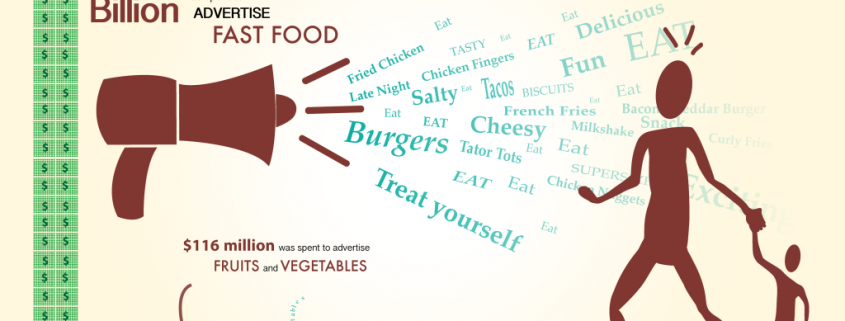Fast Food Facts

In 2012, Fast Food Restaurants spent $4.6 billion in total on all advertising, an 8% increase over 2009. This amount is 12.4 times what was spent on all advertising for milk, bottled water, vegetables, and fruit combined.
NEW STUDY
In 2010, researchers at the Yale Rudd Center for Food Policy & Obesity issued Fast Food FACTS. This report examined the nutritional quality of fast food menus, advertising on TV and the internet, and marketing practices inside fast food restaurants.
A new report Fast Food FACTS 2013 – using the same methods as the original Fast Food FACTS – quantifies changes since 2010 in the nutritional quality of fast food and how it is marketed to children and teens.
SOME GOOD NEWS
Since 2007, visits to fast food restaurants that included a kids’ meal purchase have declined, with a 5 % drop from 2010 to 2011.
The nutritional quality of individual items offered with kids’ meals has improved. McDonald’s now automatically includes half portions of French fries and apples with their Happy Meals. Most fast food restaurants now offer at least one healthy side option and 75% increased healthy beverage options.
NOT GOOD ENOUGH
Less than 1% of all kids meal combinations—33 out of 5,427 possible meals—meet recommended nutrition standards.
Less than 25% of fast food restaurant’s regular menu items qualify as nutritious for teens.
Only Subway, Burger King, Taco Bell, Arby’s and Jack in the Box offered main dish options that were not too high in calories, sodium or saturated fat. Burger King Smoothies are the only nutritious regular menu item frequently advertised to teens.
For information on selecting healthy kids meals or regular menu items for kids at fast food restaurants, check out fastfoodmarketing.org’s list of the Best Kids’ Meal Combinations, 18 of which meet all nutrition criteria for preschool and elementary school-age children. Arby’s Kraft macaroni and cheese with apple slices, and bottle water tops the list.
EXPOSURE TO ADVERTISING
TV advertising viewed by children ages 6 to 11 declined by 10%. McDonald’s and Burger King reduced TV advertising to children by 13% and 50% respectively.
Popular child-targeted websites from McDonald’s, Burger King, and Dairy Queen were discontinued. HappyMeal.com was the only child-targeted website with over 100,000 monthly unique child visitors in 2012, compared with four sites in 2009. The Campaign for a Commercial-Free Childhood launched a campaign to shut down this last of the child-targeted websites.
On the down side, fast food restaurants continue to target black and Hispanic youth, who face higher risk for obesity and food-related diseases. Advertising spending on Spanish-language TV increased by 8% overall, while KFC and Burger King increased their spending by 35% or more while reducing English-language advertising.
RECOMMENDATIONS
The researchers at the Yale Rudd Center for Food Policy & Obesity note that while there have been some improvements in 2013, the pace is slow and unlikely to make an impact.
Specific recommendations:
Apply industry standards for healthy kids’ meals to the majority of kids’ meal combinations available for purchase, not a mere 3%.
Automatically provide healthy sides and beverages as the defaults in kids’ meals.
Increase the proportion of lower-calorie, healthy items on regular menus and make them affordable.
Limit advertising on children’s TV networks and third-party kids websites to healthy kids’ meals only.
Stop unfair marketing targeted at children, including ads that focus on games and promotions, not food.
Ensure that preschoolers are not exposed to fast food advertising, especially advertising on Spanish-language TV.
Stop targeting middle school children (ages 12-14) with marketing for unhealthy fast food that can damage their health.
Establish age limits on marketing to youth via social media and mobile devices, marketing that takes advantage of their susceptibility to peer pressure.
……………………………………………………………………………………………………
 Peggy O’Mara is the CEO of peggyomara.com. She was the editor and publisher of Mothering from 1980 to 2011. The author of Having a Baby Naturally; Natural Family Living; The Way Back Home; and A Quiet Place, Peggy has conducted workshops at Omega Institute, Esalen, La Leche League, and Bioneers. She is the mother of four and grandmother of two and has lived in Santa Fe since 1984.
Peggy O’Mara is the CEO of peggyomara.com. She was the editor and publisher of Mothering from 1980 to 2011. The author of Having a Baby Naturally; Natural Family Living; The Way Back Home; and A Quiet Place, Peggy has conducted workshops at Omega Institute, Esalen, La Leche League, and Bioneers. She is the mother of four and grandmother of two and has lived in Santa Fe since 1984.


